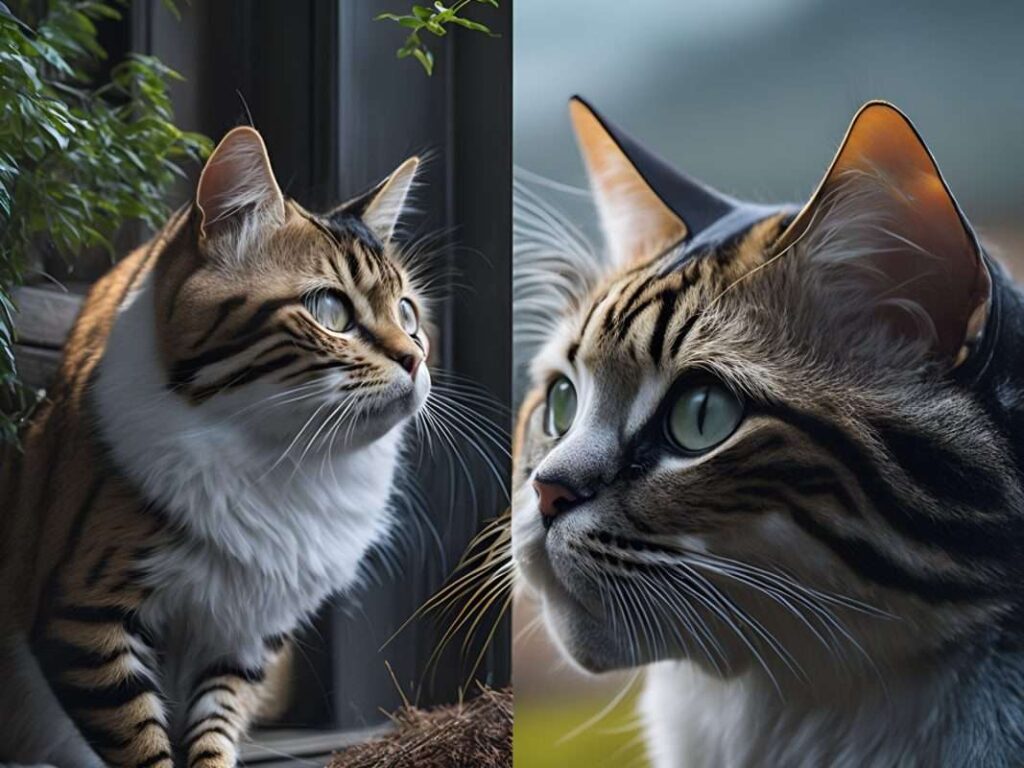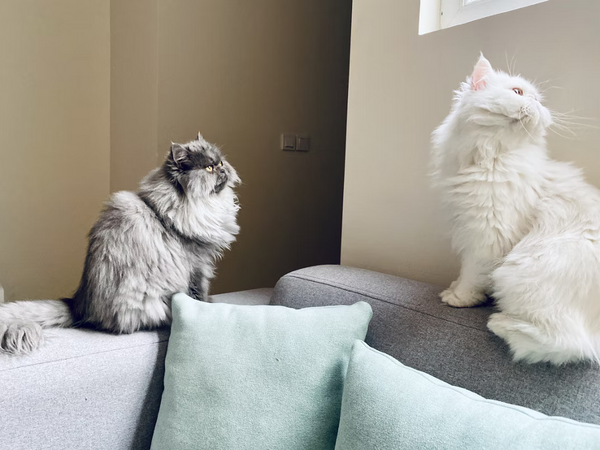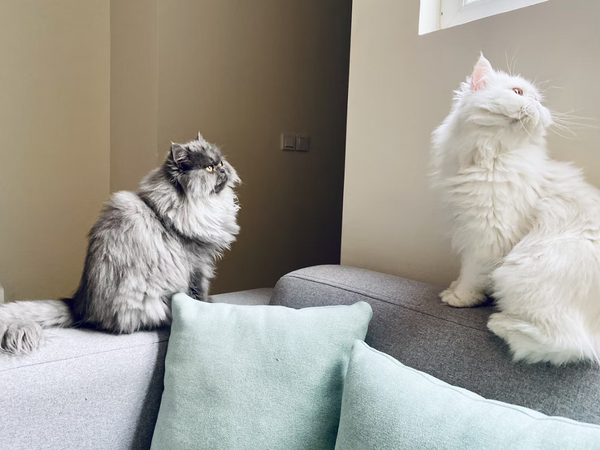If you’ve ever owned a Persian cat, you know they are the epitome of grace and elegance. These beautiful creatures require a peaceful and nurturing environment to thrive. But as a responsible pet owner, you may find yourself pondering one crucial question: should you keep your Persian cat indoors or allow them to roam freely outdoors? In this article, we will explore the contrasting advantages and disadvantages of both options, helping you make an informed decision that ensures the well-being and happiness of your feline companion.
Indoor vs. outdoor living for Persian cats is a topic that sparks heated debates in the feline community. While some argue that indoor life is safer and more secure, others believe that exposure to the great outdoors is essential for a cat’s physical and mental stimulation. Our goal here is to provide you with a balanced and comprehensive overview, empowering you to choose the right environment for your beloved Persian cat. So, let’s dive into this engaging discussion and uncover the factors that may influence your decision, allowing you to create a harmonious and fulfilling life for both you and your four-legged friend.

Indoor vs. Outdoor: Choosing the Right Environment for Your Persian Cat
Persian cats are known for their luxurious coats and regal appearance, but when it comes to deciding whether they should be kept indoors or allowed to roam outdoors, there are several factors to consider. Both options have their own advantages and disadvantages, and it ultimately depends on your cat’s individual needs and temperament. In this article, we will explore the benefits of keeping a Persian cat indoors, the advantages of allowing them outdoors, the considerations for indoor cats, tips for preparing your cat for outdoor exploration, and finding a middle ground with the hybrid approach.
The Benefits of Keeping a Persian Cat Indoors
Reduced risk of injury and accidents
By keeping your Persian cat indoors, you significantly reduce the risk of them encountering accidents or getting injured. Outdoor environments can pose several dangers, such as busy roads, sharp objects, or aggressive animals. Keeping them safely inside your home ensures their well-being and minimizes the chances of accidents.
Protection from predators and other animals
Persian cats are not known for their street smarts, and they can easily become prey to predators like coyotes or stray dogs. By keeping them indoors, you provide a safe and secure environment, protecting them from potential harm and ensuring their safety.
Safer from exposure to diseases
Outdoor cats are more prone to coming into contact with diseases or parasites from other animals. By keeping your Persian cat indoors, you can minimize their exposure to contagious illnesses, parasites, or pests that could potentially harm their health.
Protection from extreme weather conditions
Persian cats have long, thick coats that make them more susceptible to heatstroke or frostbite in extreme weather conditions. By keeping them indoors, you provide a controlled environment where they can remain comfortable and protected from the elements.
Prevention of unwanted breeding
If you don’t want your Persian cat to reproduce or contribute to the overpopulation of stray cats, keeping them indoors is an effective way to prevent unwanted breeding. This helps control the cat population and ensures that your cat does not add to the already massive number of homeless felines.
Minimal exposure to toxins and chemicals
Outdoor environments often contain toxins, such as pesticides or fertilizers, that can be harmful to cats. By keeping your Persian cat indoors, you eliminate the risk of them ingesting or coming into contact with these harmful substances, ensuring their well-being.
Less chance of getting lost or stolen
Persian cats are highly sought after for their beauty and can be a target for theft. By keeping them indoors, you eliminate the risk of them getting lost or stolen, providing peace of mind knowing that they are safe within the confines of your home.
Reduced stress and anxiety
Persian cats are known for their sensitive nature, and the outdoor environment can be overwhelming for them. By keeping them indoors, you create a safe and predictable environment that minimizes stress and anxiety, promoting their overall well-being.
Less chance of engaging in destructive behavior
When cats are left outdoors, they may engage in destructive behaviors such as scratching furniture or digging up the garden. By keeping your Persian cat indoors, you can redirect their energy towards appropriate outlets, reducing the chances of them engaging in destructive behavior.
Lower maintenance and grooming needs
Persian cats require regular grooming to maintain their long, luxurious coats. By keeping them indoors, you can minimize the amount of dirt, debris, or matting their fur accumulates, making grooming sessions more manageable and reducing the frequency of professional grooming visits.
The Advantages of Allowing a Persian Cat Outdoors
Increased physical activity and exercise
Allowing your Persian cat to go outdoors provides them with the opportunity for increased physical activity and exercise. They can explore the environment, climb trees, or engage in play that stimulates their muscles and promotes a healthier lifestyle.
Opportunity for mental stimulation
The great outdoors offers a wide range of sights, sounds, and smells that can provide mental stimulation for your Persian cat. They can experience new stimuli, encounter different animals, and satisfy their natural curiosity, contributing to their mental well-being.
Exposure to sunlight and fresh air
Sunlight is an essential source of vitamin D for cats, and fresh air can provide a refreshing change from the indoor environment. Allowing your Persian cat to spend time outdoors allows them to bask in the sun’s rays and enjoy the benefits of the natural outdoor atmosphere.
Ability to fulfill natural instincts
Persian cats, like all felines, have natural instincts such as hunting, climbing, and exploring. Allowing them outdoor access provides the opportunity to fulfill these instincts, promoting their overall happiness and well-being.
Opportunity for social interaction with other animals
Outdoor environments offer the chance for your Persian cat to interact with other animals, whether they are friendly neighborhood cats or local wildlife. These social interactions can provide mental stimulation and opportunities for appropriate socialization.
Variety of environmental enrichment
The outdoor environment provides a variety of stimuli that cannot be replicated indoors. From the feel of grass beneath their paws to the sound of birds chirping, the outdoor world offers unique environmental enrichment that can enhance your Persian cat’s quality of life.
Reduced risk of obesity and related health issues
By allowing your Persian cat outdoor access, you provide them with opportunities for increased physical activity, which can help prevent obesity and related health issues. Regular exercise and movement can contribute to their overall physical health and well-being.
Improved overall well-being and happiness
Being able to explore the outdoors and engage in natural behaviors can greatly contribute to your Persian cat’s overall well-being and happiness. Outdoor access allows them to experience a greater sense of freedom, which can positively impact their mental and emotional state.
Less need for litter box cleaning
When your Persian cat has outdoor access, they may prefer to relieve themselves outside, reducing the frequency of litter box cleaning. This can be a convenience for cat owners who prefer not to clean the litter box as frequently.
Less chance of developing behavioral problems
Providing outdoor access can help prevent behavioral problems such as excessive scratching, aggression, or inappropriate elimination. By allowing your Persian cat to fulfill their natural instincts and release their energy outdoors, they are less likely to exhibit these behaviors indoors.
Considerations for Keeping a Persian Cat Indoors
Providing a safe and stimulating indoor environment
When keeping a Persian cat indoors, it is essential to create a safe and stimulating environment for them. This includes providing scratching posts, toys, and comfortable resting areas. Vertical spaces such as cat trees or shelves can also offer opportunities for climbing and exploration.
Ensuring proper nutrition and exercise
Indoor cats tend to have lower activity levels compared to outdoor cats, which can make them more prone to weight gain. To prevent obesity and maintain their health, it is crucial to provide proper nutrition and engage them in regular exercise or play sessions.
Engaging in interactive play and mental stimulation
Persian cats are intelligent and require mental stimulation to prevent boredom and behavioral issues. Interactive play sessions, puzzle toys, or food puzzles can help keep their minds active and engaged.
Implementing a consistent routine and schedule
Cats thrive on routine, so it is important to establish a consistent schedule for feeding, playtime, and other daily activities. Predictability helps reduce stress and anxiety for your Persian cat.
Offering scratching posts and climbing opportunities
Persian cats have a natural instinct to scratch and climb, so providing appropriate scratching posts and climbing opportunities can help satisfy these needs and prevent damage to furniture or other belongings.
Introducing window perches and bird feeders
Window perches and bird feeders can offer entertainment for indoor cats, allowing them to observe the outdoor world from a safe and comfortable vantage point. These additions can provide mental stimulation and mimic the experience of being outdoors.
Providing appropriate litter box options
Indoor cats rely on litter boxes for their bathroom needs, so it is important to provide clean, easily accessible litter boxes in quiet areas of the home. Regular cleaning and maintaining a consistent litter type can help prevent litter box aversion issues.
Monitoring weight and preventing obesity
Indoor cats are at a higher risk of obesity due to their lower activity levels. Regularly monitoring your Persian cat’s weight and adjusting their diet or exercise routine as needed can help prevent weight gain and related health issues.
Ensuring regular veterinary check-ups
Regular veterinary check-ups are crucial for maintaining your Persian cat’s health, especially when they have limited exposure to the outdoors. Routine vaccinations, parasite prevention, and other healthcare needs should be addressed to keep your cat healthy and protected.
Managing shedding and grooming needs
Persian cats have long, thick coats that require regular grooming to prevent matting and skin issues. Regular brushing, bathing, and occasional professional grooming are necessary to keep their coats healthy and reduce the amount of loose hair in your home.
Preparing Your Persian Cat for Outdoor Exploration
Gradual introduction to the outdoors
If you decide to allow your Persian cat outdoor access, it is important to introduce them gradually to the outdoor environment. Start with supervised outdoor time in a secure, enclosed area, gradually increasing their exposure as they become more comfortable and familiar with their surroundings.
Ensuring vaccinations and parasite control
Before allowing your Persian cat to roam outdoors, ensure they are up to date on their vaccinations and parasite prevention treatments. This protects them from potentially dangerous diseases and parasites they may encounter outside.
Supervision and gradual increase in outdoor access
Supervision is crucial during your Persian cat’s early outdoor exploration. Gradually increase their outdoor access, allowing them to explore under your watchful eye and gradually extending the duration as they become more familiar with the area.
Use of secure enclosures and outdoor catios
To provide a safe outdoor experience, consider using secure enclosures or outdoor catios. These structures offer an enclosed space where your Persian cat can enjoy the outdoor environment while remaining protected from potential dangers.
Identification methods (microchipping, collars, tags)
When allowing your Persian cat outdoor access, it is important to ensure they are properly identified in case they become lost. Microchipping, collars with identification tags, or both, can help increase the chances of your cat being reunited with you if they stray too far from home.
Training for recall and response to commands
Training your Persian cat for recall can be instrumental in ensuring their safety when outdoors. Teach them to respond to specific commands or sounds, making it easier for you to get their attention and bring them back inside when needed.
Monitoring for signs of distress or discomfort
While your Persian cat may enjoy outdoor exploration, it is important to monitor them for any signs of distress or discomfort. This can include excessive hiding, aggression, or unusual behavior that may indicate they are overwhelmed or scared.
Choosing safe and suitable outdoor locations
When allowing your Persian cat outdoors, choose safe and suitable locations free from potential hazards such as busy roads, toxic plants, or aggressive animals. Consider the proximity to traffic and the overall safety of the area.
Consideration of local laws and regulations
Before allowing your Persian cat outdoor access, familiarize yourself with local laws and regulations regarding cats. Some areas may have leash laws or restrictions on outdoor cats, so be sure to adhere to these guidelines to ensure the safety and well-being of your cat.
Providing proper shelter and rest areas
Outdoor access should always include proper shelter for your Persian cat. Provide a cozy outdoor shelter or covered resting areas where they can seek refuge from inclement weather or rest when they need a break.
Finding a Middle Ground: The Hybrid Approach
Providing supervised outdoor time
If you’re unsure about allowing your Persian cat complete outdoor freedom, a hybrid approach may be the ideal solution. Provide supervised outdoor time where you can monitor their activities and ensure their safety while still allowing them to enjoy the benefits of the outdoor environment.
Using cat harnesses and leash training
Harness training your Persian cat can be a safe alternative to unrestricted outdoor access. With a properly fitted harness and leash, you can take your cat for outdoor walks, allowing them to explore while remaining under your control and protection.
Creating an enclosed outdoor space
Creating an enclosed outdoor space, such as a cat-proofed garden or a screened-in porch, can offer a compromise between indoor and outdoor living. This allows your Persian cat to experience the outdoors while remaining protected from potential dangers.
Offering access to a screened-in porch or balcony
If you have a screened-in porch or balcony, you can provide your Persian cat with a safe outdoor experience. These spaces allow fresh air and a view of the outdoors while eliminating the risk of them wandering away or encountering dangerous situations.
Utilizing safe and cat-friendly gardens
If your Persian cat enjoys exploring the outdoors, consider creating a safe and cat-friendly garden. This can include the addition of cat-safe plants, hiding spots, and perches, providing them with a controlled outdoor experience that meets their natural instincts.
Balancing indoor and outdoor stimulation
Whether you choose complete indoor living, supervised outdoor time, or another approach, the key is to strike a balance that meets your Persian cat’s needs for both physical and mental stimulation. Providing a mix of both environments can help keep your cat happy and satisfied.
Considering individual cat preferences
Every Persian cat is unique with their own personality and preferences. Some may thrive being exclusively indoors, while others may long for outdoor exploration. Consider your cat’s individual needs and desires when determining the best living arrangement for them.
Monitoring for signs of dissatisfaction or stress
Regardless of the approach you choose, it is essential to monitor your Persian cat for any signs of dissatisfaction or stress. If your cat seems unhappy or exhibits unusual behavior, it may be necessary to reassess their living environment and make adjustments accordingly.
Adapting the environment based on the cat’s needs
As your Persian cat grows and experiences different stages in life, their needs may change. Be adaptable and willing to make adjustments to their indoor or outdoor environment based on their changing preferences and requirements.
Consulting with a veterinarian or cat behaviorist
If you’re unsure about the best living arrangement for your Persian cat or need guidance on how to transition them to the outdoors, consult with a veterinarian or cat behaviorist. These professionals can provide expert advice tailored to your cat’s individual needs.
Conclusion
Choosing the right environment for your Persian cat requires careful consideration of their individual needs, temperament, and the potential risks and benefits associated with both indoor and outdoor living. Whether you decide to keep your cat indoors, allow them supervised outdoor access, or find a middle ground with the hybrid approach, the key is to provide a loving and enriching environment that prioritizes their safety, health, and overall well-being. By understanding your Persian cat’s unique needs and making informed decisions, you can create a living arrangement that ensures their happiness and quality of life for years to come.

